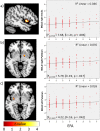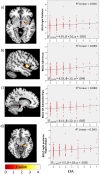Impact of early life adversity on reward processing in young adults: EEG-fMRI results from a prospective study over 25 years
- PMID: 25118701
- PMCID: PMC4131910
- DOI: 10.1371/journal.pone.0104185
Impact of early life adversity on reward processing in young adults: EEG-fMRI results from a prospective study over 25 years
Erratum in
- PLoS One. 2014;9(10):e112155
Abstract
Several lines of evidence have implicated the mesolimbic dopamine reward pathway in altered brain function resulting from exposure to early adversity. The present study examined the impact of early life adversity on different stages of neuronal reward processing later in life and their association with a related behavioral phenotype, i.e. attention deficit/hyperactivity disorder (ADHD). 162 healthy young adults (mean age = 24.4 years; 58% female) from an epidemiological cohort study followed since birth participated in a simultaneous EEG-fMRI study using a monetary incentive delay task. Early life adversity according to an early family adversity index (EFA) and lifetime ADHD symptoms were assessed using standardized parent interviews conducted at the offspring's age of 3 months and between 2 and 15 years, respectively. fMRI region-of-interest analysis revealed a significant effect of EFA during reward anticipation in reward-related areas (i.e. ventral striatum, putamen, thalamus), indicating decreased activation when EFA increased. EEG analysis demonstrated a similar effect for the contingent negative variation (CNV), with the CNV decreasing with the level of EFA. In contrast, during reward delivery, activation of the bilateral insula, right pallidum and bilateral putamen increased with EFA. There was a significant association of lifetime ADHD symptoms with lower activation in the left ventral striatum during reward anticipation and higher activation in the right insula during reward delivery. The present findings indicate a differential long-term impact of early life adversity on reward processing, implicating hyporesponsiveness during reward anticipation and hyperresponsiveness when receiving a reward. Moreover, a similar activation pattern related to lifetime ADHD suggests that the impact of early life stress on ADHD may possibly be mediated by a dysfunctional reward pathway.
Conflict of interest statement
Figures




Similar articles
-
Interaction between COMT Val(158)Met polymorphism and childhood adversity affects reward processing in adulthood.Neuroimage. 2016 May 15;132:556-570. doi: 10.1016/j.neuroimage.2016.02.006. Epub 2016 Feb 12. Neuroimage. 2016. PMID: 26879624
-
Effect of brain structure and function on reward anticipation in children and adults with attention deficit hyperactivity disorder combined subtype.Soc Cogn Affect Neurosci. 2015 Jul;10(7):945-51. doi: 10.1093/scan/nsu135. Epub 2014 Oct 22. Soc Cogn Affect Neurosci. 2015. PMID: 25338631 Free PMC article.
-
Children with ADHD symptoms show decreased activity in ventral striatum during the anticipation of reward, irrespective of ADHD diagnosis.J Child Psychol Psychiatry. 2017 Feb;58(2):206-214. doi: 10.1111/jcpp.12643. Epub 2016 Sep 28. J Child Psychol Psychiatry. 2017. PMID: 27678006
-
Brain activations associated with anticipation and delivery of monetary reward: A systematic review and meta-analysis of fMRI studies.PLoS One. 2021 Aug 5;16(8):e0255292. doi: 10.1371/journal.pone.0255292. eCollection 2021. PLoS One. 2021. PMID: 34351957 Free PMC article.
-
Ventral-striatal responsiveness during reward anticipation in ADHD and its relation to trait impulsivity in the healthy population: a meta-analytic review of the fMRI literature.Neurosci Biobehav Rev. 2014 Jan;38:125-34. doi: 10.1016/j.neubiorev.2013.07.012. Epub 2013 Aug 6. Neurosci Biobehav Rev. 2014. PMID: 23928090 Free PMC article. Review.
Cited by
-
Leveraging translational neuroscience to inform early intervention and addiction prevention for children exposed to early life stress.Neurobiol Stress. 2018 Oct 26;9:231-240. doi: 10.1016/j.ynstr.2018.10.004. eCollection 2018 Nov. Neurobiol Stress. 2018. PMID: 30450387 Free PMC article. Review.
-
Differential Associations of Distinct Forms of Childhood Adversity With Neurobehavioral Measures of Reward Processing: A Developmental Pathway to Depression.Child Dev. 2019 Jan;90(1):e96-e113. doi: 10.1111/cdev.13011. Epub 2017 Dec 21. Child Dev. 2019. PMID: 29266223 Free PMC article.
-
Exposure to community violence as a mechanism linking neighborhood socioeconomic disadvantage and neural responses to reward.Soc Cogn Affect Neurosci. 2024 May 6;19(1):nsae029. doi: 10.1093/scan/nsae029. Soc Cogn Affect Neurosci. 2024. PMID: 38619118 Free PMC article.
-
Early adverse experience and substance addiction: dopamine, oxytocin, and glucocorticoid pathways.Ann N Y Acad Sci. 2017 Apr;1394(1):74-91. doi: 10.1111/nyas.13140. Epub 2016 Aug 10. Ann N Y Acad Sci. 2017. PMID: 27508337 Free PMC article. Review.
-
Early life stress and brain function: Activity and connectivity associated with processing emotion and reward.Neuroimage. 2020 Apr 1;209:116493. doi: 10.1016/j.neuroimage.2019.116493. Epub 2019 Dec 27. Neuroimage. 2020. PMID: 31884055 Free PMC article. Review.
References
-
- Lupien SJ, McEwen BS, Gunnar MR, Heim C (2009) Effects of stress throughout the lifespan on the brain, behaviour and cognition. Nat Rev Neurosci 10: 434–445. - PubMed
-
- Heim C, Binder EB (2012) Current research trends in early life stress and depression: review of human studies on sensitive periods, gene-environment interactions, and epigenetics. Exp Neurol 233: 102–111. - PubMed
-
- Pheula GF, Rohde LA, Schmitz M (2011) Are family variables associated with ADHD, inattentive type? A case-control study in schools. Eur Child Adolesc Psychiatry 20: 137–145. - PubMed
-
- Laucht M, Hohm E, Esser G, Schmidt MH, Becker K (2007) Association between ADHD and smoking in adolescence: shared genetic, environmental and psychopathological factors. J Neural Transm 114: 1097–1104. - PubMed
Publication types
MeSH terms
LinkOut - more resources
Full Text Sources
Other Literature Sources
Medical

